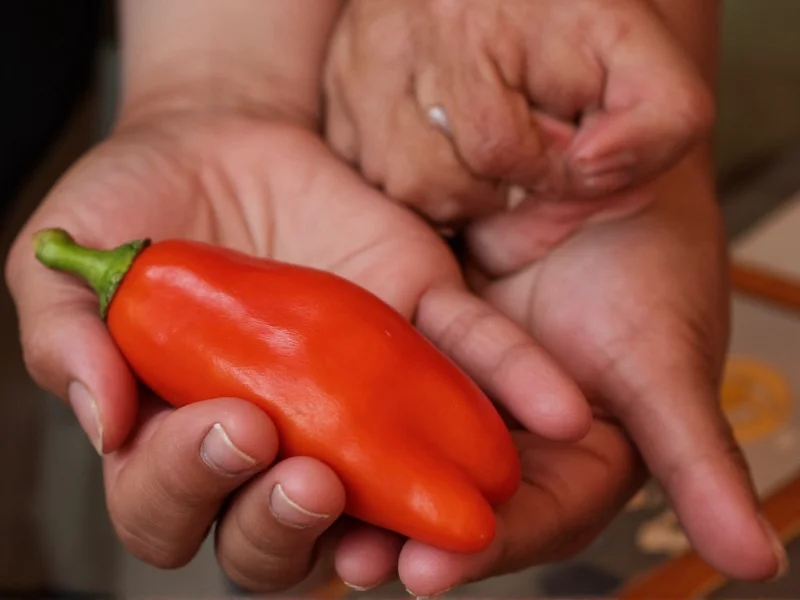If you've ever handled hot peppers like habaneros or ghost peppers and felt that intense burning sensation on your hands, you know how urgent it is to find relief. Many people make the mistake of reaching for water first, but this actually worsens the problem. Understanding why certain methods work while others don't can save you from unnecessary discomfort and potentially dangerous mistakes.
Why Water Makes Hot Pepper Burns Worse
Capsaicin, the active compound in hot peppers that causes the burning sensation, is hydrophobic and lipophilic. This scientific terminology simply means it repels water but bonds with fats and oils. When you wash your hands with water after handling hot peppers, you're essentially spreading the capsaicin across your skin rather than removing it. This explains why the burning sensation often intensifies after washing with water alone.
Most Effective Methods to Remove Hot Pepper Residue
Understanding capsaicin's chemical properties is key to selecting the right removal method. The following approaches work because they address the oil-soluble nature of capsaicin:
Oil-Based Solutions
Since capsaicin dissolves in oil, applying oil first helps break down the compound before washing:
- Cooking oil method: Apply vegetable oil, olive oil, or any cooking oil to affected areas. Massage gently for 30-60 seconds, then wash thoroughly with soap and warm water.
- Duration: Continue washing for at least 2 minutes to ensure complete removal.
Dairy Products
Dairy contains casein, a protein that binds to capsaicin and helps remove it from skin receptors:
- Milk soak: Submerge hands in cold milk for 5-10 minutes. Whole milk works best due to higher fat content.
- Yogurt application: Apply plain yogurt to affected areas, leave for 5 minutes, then rinse.
Alcohol-Based Solutions
High-proof alcohol can dissolve capsaicin effectively:
- Rubbing alcohol: Apply 70% isopropyl alcohol to a cotton ball and gently wipe affected areas, then wash with soap.
- Hand sanitizer: Many contain enough alcohol to provide temporary relief (check for at least 60% alcohol content).
| Method | Effectiveness | Time Required | Notes |
|---|---|---|---|
| Cooking oil + soap | ★★★★☆ | 3-5 minutes | Most accessible household solution |
| Milk soak | ★★★★☆ | 5-10 minutes | Provides cooling effect |
| Rubbing alcohol | ★★★☆☆ | 2-3 minutes | May cause temporary stinging |
| Baking soda paste | ★★☆☆☆ | 5-7 minutes | Less effective than oil-based methods |
| Water alone | ★☆☆☆☆ | 1-2 minutes | Spreads burning sensation |
Step-by-Step Guide for Immediate Relief
When you need to get hot pepper off hands quickly, follow this proven sequence:
- Stop touching anything - Prevent spreading capsaicin to other surfaces or your face
- Apply oil first - Massage cooking oil into affected areas for 30-60 seconds
- Wash with soap - Use warm water and soap for at least 2 minutes
- Rinse thoroughly - Ensure all oil and soap residue is removed
- Repeat if necessary - For extremely hot peppers, repeat the process
- Apply soothing agent - After cleaning, use aloe vera or milk for additional relief
Common Mistakes to Avoid
When trying to stop hands burning after handling peppers, avoid these counterproductive actions:
- Using only water - As explained, this spreads the capsaicin rather than removing it
- Rubbing hands vigorously - This can damage skin and spread the compound
- Touching face or eyes - Even after washing, residual capsaicin can cause severe irritation
- Using harsh chemicals - Bleach or strong solvents can damage skin without effectively removing capsaicin
Preventing Pepper Burn During Future Cooking
The best approach for how to prevent pepper burn when cooking is prevention:
- Wear disposable gloves - Nitrile gloves work better than latex for handling hot peppers
- Prepare a cleaning station - Have oil, soap, and paper towels ready before handling peppers
- Avoid touching face - Establish the habit of not touching your face while cooking with hot ingredients
- Cut peppers on dedicated cutting board - Prevent cross-contamination with other foods
When to Seek Medical Attention
While how to get hot pepper off hands is usually manageable at home, seek medical help if:
- Burning sensation persists for more than 24 hours despite proper treatment
- Signs of skin damage appear (blistering, severe redness, peeling)
- You experience difficulty breathing or swelling
- Capsaicin has contacted eyes or mucous membranes
Scientific Explanation Behind Effective Remedies
Understanding what neutralizes capsaicin on skin requires basic chemistry knowledge. Capsaicin molecules have a long hydrocarbon tail that makes them highly non-polar. This is why polar substances like water can't dissolve them effectively. Non-polar substances like oils, alcohols, and the casein protein in dairy can break these bonds. The effectiveness of each method directly correlates with how well the substance can dissolve or bind to capsaicin molecules.











 浙公网安备
33010002000092号
浙公网安备
33010002000092号 浙B2-20120091-4
浙B2-20120091-4